
Alandroal is a municipality in the Portuguese district of Évora located on the eastern frontier with Spain along the right margin of the Guadiana River in the Central Alentejo region. It is located 341 metres (1,119 ft) above sea level, northeast of Évora and southeast of Estremoz. The population in 2011 was 5,843, in an area of 542.68 km².
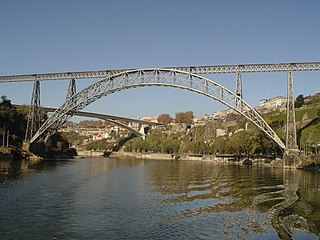
The Maria Pia Bridge is a railway bridge built in 1877, and attributed to Gustave Eiffel, situated over the Portuguese northern municipalities of Porto and Vila Nova de Gaia.

Paderne is a civil parish in the municipality (concelho) of Albufeira, in the Portuguese subregion of the Algarve. The population in 2011 was 3,304, in an area of 52.56 km².

The Dom Luís I Bridge, or Luís I Bridge, is a double-deck metal arch bridge that spans the River Douro between the cities of Porto and Vila Nova de Gaia in Portugal. At its construction, its 172 metres (564 ft) span was the longest of its type in the world. It has been confused with the nearby Maria Pia Bridge, a railway bridge that was built 9 years earlier, which is similar in aspect to the Luís I bridge.
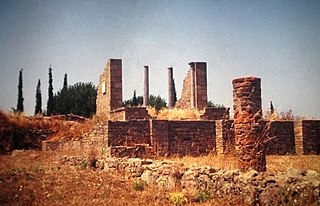
Miróbriga is an ancient Roman town located near the village and civil parish of Santiago do Cacém, in the municipality of the same name in the south-west of Portugal. Archeology revealed that the town occupied the site of an ancient Iron Age settlement that existed since the 9th century B.C.

The Fort of Santa Catarina is a medieval fort situated in the civil parish of Portimão, in the municipality of Portimão in Portuguese Algarve. The structure was considered one of the last Philippine military projects in the Algarve, erected to defend the peninsula from pirates and privateers, as well as military invasions. Its construction is one of the better examples that work of Alexandre Massai, a military engineer who toured the Algarve to reinforce numerous military fortifications along the coast.

The Fort of Nossa Senhora da Rocha is a medieval castle is situated in the civil parish of Porches, in the municipality of Lagoa in Portuguese Algarve. Inside the fort is the Chapel of Nossa Senhora da Rocha, of uncertain date.
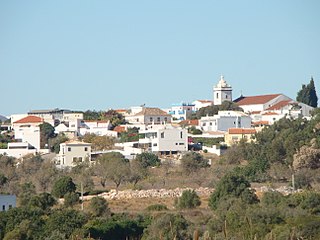
Mexilhoeira Grande is a civil parish in the municipality (concelho) of Portimão in the southern Portuguese region of the Algarve. The population in 2011 was 4,029, in an area of 91.15 km².

The Castle of Alcoutim is a medieval castle in the civil parish of Alcoutim, in the municipality of the same name, in the southeastern Algarve of Portugal. Built in the 13th century, the castle stands in a dominant position on a hill south of the parish seat of Alcoutim on the right bank of the San Marcos River, opposite the territory of Sanlúcar de Guadiana.
The Ponte da Palhaça is a bridge crossing the Ribeira da Tojeira in the civil parish of Palhaça, municipality of Oliveira do Bairro in the Portuguese district of Aveiro.
The Bridge of Fontinha is a medieval is a bridge situated in the civil parish of Roge, in the municipality of Vale de Cambra, Portuguese district of Aveiro.
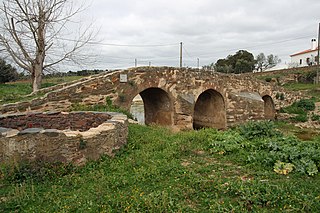
The Ponte da Ribeira de Cobres is a bridge in the civil parish, in the municipality of Almodôvar in the Portuguese district of Beja.

Ponte de Mem Gutierres is a Romanesque bridge in Portugal, located in the civil parish of Esperança e Brunhais, in the municipality of Póvoa de Lanhoso. Crossing the river Ave in the district of Braga, the bridge connects either margin lined with picturesque houses.
Ponte Velha de São Pedro da Torre is a bridge in the civil parish of São Pedro da Torre, municipality of Valença in the Portuguese district of Viana do Castelo.
The Old Bridge of Santo Adrião is a two-arch bridge over the Rio Tedo in the civil parish of Vila Seca e Santo Adrião, municipality of Armamar, the Portuguese district of Viseu.
The Castle of Aljustrel, is a Portuguese medieval castle in civil parish of Aljustrel e Rio de Moinhos, in the municipality of Aljustrel, in the district of Beja.

Torrão is a civil parish and town, in the municipality of Alcácer do Sal, in the Portuguese district of Setúbal, bordering on the districts of Évora and the Beja. It is crossed by the river Xarrama River. The population in 2011 was 2,295, in an area of 372.39 km².
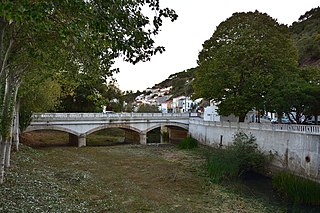
The Ponte de Aljezur, is a structure located over the Ribeira de Aljezur, in the civil parish of Aljezur, municipality of Aljezur, in the Portuguese district of Faro.














